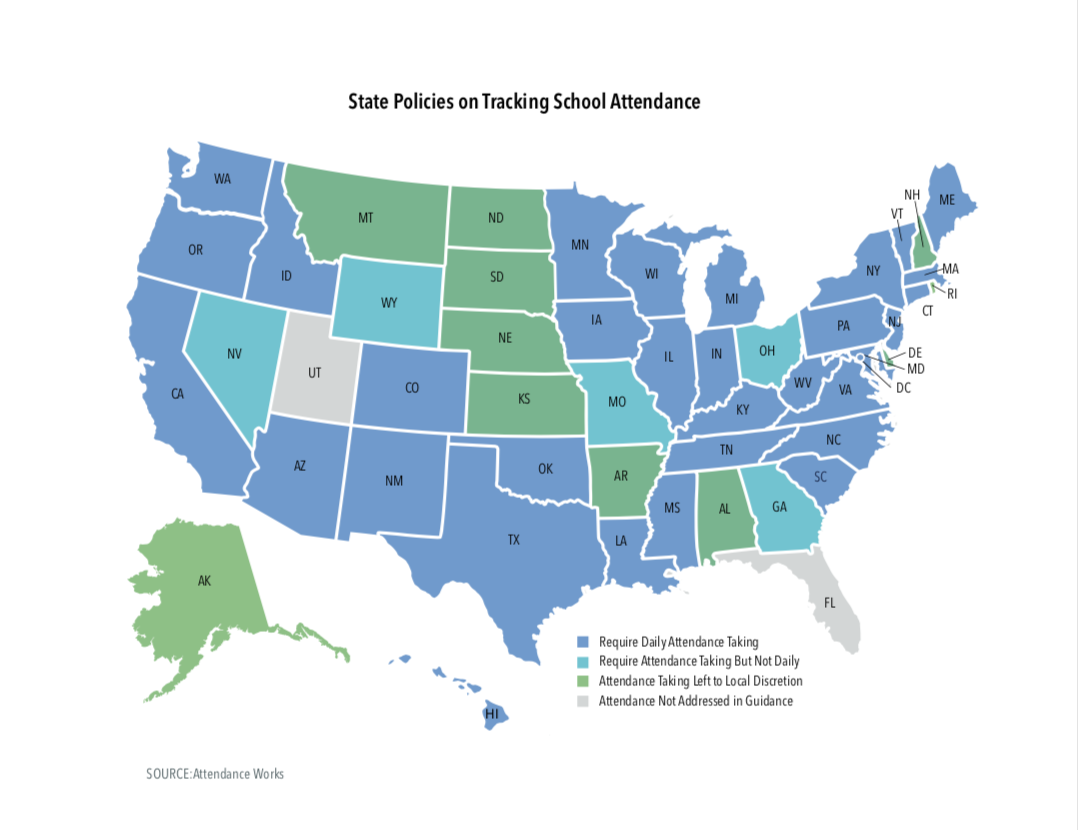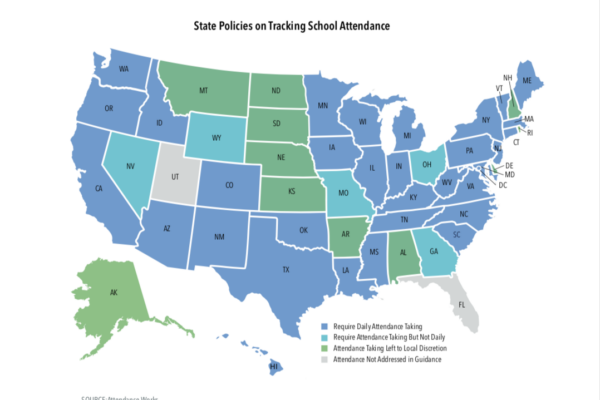Amid news of rising student absenteeism rates and declining school enrollment during the pandemic, a new report from Attendance Works details how states are tracking attendance and what they should do to ensure students have an equal opportunity to learn during the COVID crisis. The national nonprofit reviewed state guidance and legislation and consulted with state attendance officials and the Council of Chief State School Officers. FutureEd Editorial Director Phyllis Jordan spoke with Attendance Works Executive Director Hedy Chang about her organization’s research.
When the pandemic shut down schools last spring, a lot of states stopped taking attendance. What is the situation this fall?
At this point, it appears the majority of states have reinstated daily attendance-taking. We found that 32 states and the District of Columbia, have requirements that attendance be taken daily. Another five states require attendance be taken, but not daily, Eleven states leave the decision about how and when to track attendance to local discretion. In two states, attendance expectations were not explicitly addressed in available guidance.
As you said, the pandemic initially caused a dramatic decrease in attendance data collection last spring. One analysis found only 27 percent of districts continued taking attendance when school buildings closed and shifted to remote learning. This was especially true in lower-income and more rural districts.
It seems things are moving in the right direction? What advice are you giving states?
Short term, states should require districts to take daily attendance  and should help them use the attendance data, on hand, to identify students who are experiencing challenges. That can mean looking at which students have missed 10 percent or more of school in the current school year, and which students missed 10 percent or more of school prior to the pandemic.
and should help them use the attendance data, on hand, to identify students who are experiencing challenges. That can mean looking at which students have missed 10 percent or more of school in the current school year, and which students missed 10 percent or more of school prior to the pandemic.
In that way, educators, community partners and policymakers can determine who is starting to miss too much school so they can take preventive action in a timely manner. Even if states aren’t requiring daily attendance taking, they could promote localities that are doing so as a matter of effective practice. Ideally states would use this data to start conversations across disciplines, departments and agencies about how to create a more equitable opportunity to learn.
What is the connection between monitoring attendance and addressing the challenge of so many students simply falling off the rolls?
States and districts are starting to report significant declines in enrollment among the youngest learners as well as older students. These declines are troubling because they, like absenteeism, are an indicator of students who are missing out on learning opportunities. Enrollment declines also make monitoring absenteeism even more important because that monitoring helps to identify students in need of outreach and support to ensure they do not disenroll.
Districts need to know which of these students would have been in kindergarten and are delaying their start. Which ones have moved temporarily and will come back next year. Which ones have gone to online schools, but will come back when schools reopen.
For the states, the biggest issue is funding, since enrollment and average daily attendance determine how states fund schools. The cost of education that supports students’ academic recovery is going to be higher, but there’s a risk that we’re going to be funding schools at lower levels post-pandemic.
How are the states defining attendance during remote learning? It seems like there’s a lot of room for variation even when there’s state guidance.
There is huge room for variation as states and often localities are left to decide what is attendance. Is it showing up to a virtual class? Logging on to a learning management system? Turning in an assignment? Or an interaction by phone or computer between the teacher and a student or a family member?
Before the pandemic, attendance data was used both to measure the student’s exposure to learning and to identify when students and families were facing challenges or were disengaging. While attendance taken in the classroom can serve these multiple purposes, it’s harder to do that during remote learning. For example, a brief two-way interaction with a family helps monitor well-being and engagement. But it does not measure participation in learning.
[Read More: The Challenge of Taking Attendance in Remote Learning]
To make matters even more complicated, the data essential for monitoring participation during remote learning is often captured by a learning management system, which is the software used to offer on-line learning and collect student assignments. Or it can be collected through other software like Zoom. But attendance is typically recorded in a student information system. Those different data systems don’t always communicate, leaving educators to transfer data manually, which is a lot of work for educators. The technological fixes we need are still being developed.
What are you recommending that states should monitor?
For this school year, we recommend state and districts pay attention to a series of metrics to determine whether students are getting an opportunity to learn. Those include contact (has the school been able to contact students and families); connectivity (do students have the technology they need for virtual instruction); relationships (are we building relationships and a sense of connection with the student and their families); and participation (are students showing up for learning activities and turning in assignments). These metrics paint a holistic picture of whether students are positioned to benefit from distance and blended learning opportunities.
For the longer-term, states should do research and data analysis to determine which attendance metrics are associated with lower academic performance in remote or hybrid learning. Unfortunately, such research does not exist. Ideally states can use the data collected this fall to determine what are the most meaningful metrics and then use those insights to inform their attendance guidance for the next school year. And they can invest in the technology needed to integrate all the data they’re getting across learning management systems, student information systems or other online platforms.
[Read More: Attendance Playbook: Smart Solutions for Reducing Chronic Absenteeism in the Covid Era]
The pandemic accelerates the shift to blended and virtual learning. The question is whether blended learning will become a longer-term tool for increasing access for students who face barriers to getting to school or will it simply add to educational inequities. We need to re-invent attendance metrics so they serve as effective early warning metrics in order to reduce inequities.
Given that attendance is a metric considered when many states assess school quality, how should states handle the accountability question?
We suggest states to refrain from using chronic absence as an accountability measure until we have more research on attendance and absenteeism during remote or hybrid learning. States should also ask the federal government to waive accountability requirements for identifying schools in need of improvement for the 2020-2021 school year. But we still need the data to be collected and reported so that we can understand the scale of the pandemic’s impact on learning.
